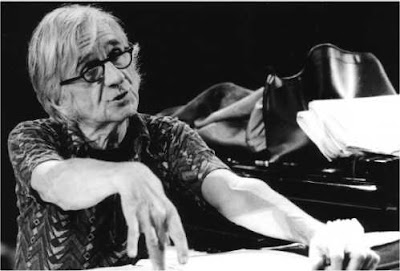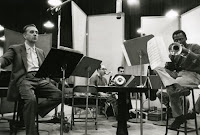by Something Else Reviews
Composer/producer Ryan Truesdell on Wednesday launched the Gil Evans Centennial Project at GilEvansProject.com. There’s news: Truesdell, the first person outside of the Evans family to have full access to his musical archives, has uncovered a series of rare compositions, from before and after Evans’ celebrated collaborations with Miles Davis.
“Gil was an amazingly prolific composer and arranger,” Truesdell says. “I saw thousands of pages of music manuscript, more tunes than I could count. As I went through this music, I started to realize that so many of these were never recorded or were heard live only a few times.” Among them: late-1940s compositions from Evans’ tenure with the Claude Thornhill Orchestra; an unused tune originally arranged for Astrid Gilberto; and never-before-heard works for a 24-piece ensemble.
You can follow along and discover various ways to contribute at GilEvansProject.com, powered by ArtistShare, as Truesdell continues his archival work, then oversees the recording, mixing and final release of a commemorative CD scheduled for May 13, 2012, on what would have been Evans’ 100th birthday. Things get underway next month, as special guests Phil Woods, Andy Bey and Frank Kimbrough join the Eastman School of Music Chamber Jazz Ensemble conducted by Truesdell for a New York City kick-off concert on March 13, 2011.
To get you ready, here’s a look back at some of our thoughts on Evans from the Something Else! Reviews archives. Click through the album titles for expanded versions …
MILES DAVIS WITH GIL EVANS, MILES AHEAD (1957): Initially billed by Columbia Records, in the flatly obvious tone of the day, as “Miles Davis plus 19, with Gil Evans.” Right. Still, it was that last guy, the 20th man, who was the important one. After a burst of creativity in the late 1940s — the clearest result being the very cool but obviously embryonic Birth of the Cool on Capitol — Evans didn’t work with Miles again until the late 1950s. Davis seemed better for the reunion, as this record touched off an incredible rejuvenation, for both Miles Davis and for Gil Evans. Next from these two came Porgy and Bess, issued a year later; and then Sketches of Spain from 1960, both also on Columbia Records. Too, arguably the best recordings by Evans and Davis apart from each other as band leaders are from this period, as well: Miles’ 1959 Kind of Blue and Gil’s 1960 Impulse LP Out of the Cool.
GIL EVANS, OUT OF THE COOL (1960): Evans was, of course, an key influence on several high points in the Davis catalog, notably Porgy and Bess, where Evans’ sensitive arrangements provided the space for Davis to move inside and around the Gershwin piece’s theme. Here, Evans creates the same generous context, all the while neatly juxtaposing a California-smooth band against the complex rhythms of bassist Ron Carter and drummer Elvin Jones. Evans’ flair for pacing, tone and creative construction are perhaps best heard on the lengthy opening cut, “Le Nevada,” which swings for two full minutes before the larger group enters.
MILES DAVIS AND QUINCY JONES, MILES AND QUINCY: LIVE AT MONTREUX (1993): The last thing Miles, never one prone to nostalgia, recorded before his death was startling indeed. It’s a loving look back, recorded with the old Gil Evans arrangements. Quincy Jones conducted the outing — which included cuts from Birth of the Cool, Porgy and Bess, Sketches of Spain and Miles Ahead. The beauty is not in the telling: Miles is clearly about to succumb to those things which ailed him. The beauty is that this fierce rebel, this restless wanderer, would have taken the time to revisit these wonders at all. Even on the first listen, I had the feeling that this was a once-in-a-lifetime moment. Sadly, that’s all too right: A few weeks after this concert, Davis was gone. What a treat it is, though, to hear Evans’ work performed again live, and with his most famous collaborator. Miles and Quincy, in the end, celebrates the fertile relationship between Davis and Evans, working on separate levels as eulogy, primer and swinging good time.
- Nick DeRiso’s Best of 2015 (Rock + Pop): Death Cab for Cutie, Joe Jackson, Toto + Others - January 18, 2016
- Nick DeRiso’s Best of 2015 (Blues, Jazz + R&B): Boz Scaggs, Gavin Harrison, Alabama Shakes - January 10, 2016
- Nick DeRiso’s Best of 2015 (Reissues + Live): John Oates, Led Zeppelin, Yes, Faces + others - January 7, 2016






Awesome! I hated Sketches of Spain, when I first got it, but now I love it.
I was initially attracted to fast moving and swinging jazz, like Blakey and Coltrane.
While I still love them, I have come to appreciate Gil Evans' style a lot more. Glad to see his centennial is being properly commemorated!